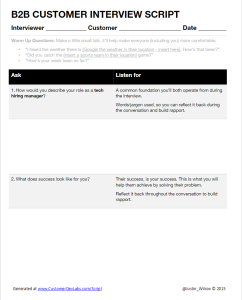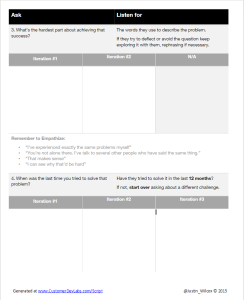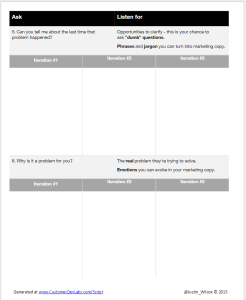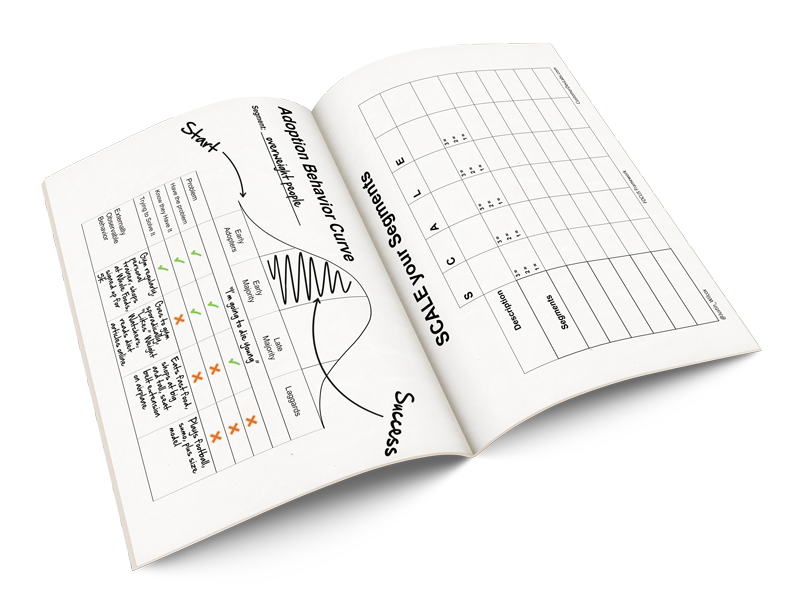Interviewing Customers is a Special Kind of Torture
- Talk to a stranger. Fun.
- That stranger is immensely busy…and hates being sold things. Getting better.
- That stranger will likely destroy your vision for a company. Ready to get started?!
When I started interviewing customers, the only thing I cared less about than talking about other people’s problems, was asking about them. So, I skipped all the questions I thought were BS, and jumped to the most important ones:
and
Turns out, those aren’t the most important questions…they’re the most misleading. Apparently, I am not a natural interviewer.
When I realized interviewing customers meant standing in front of strangers doing something I was awful at, any enthusiasm I had towards “getting out of the building”, evaporated.
When I see other founders hesitate to interview customers, or do them wrong, I empathize. I’ve been there. It’s a daunting task we have no experience with – and – isn’t nearly as fun as building stuff.
Let’s Fix That
Despite my early misgivings, learning to interview customers has become one of my most indispensable skills. Not just because it gives me a leg up on competitors, not because it helps me (in)validate ideas quickly, and not because it helps in my personal life as much as it does my professional. It’s indispensable because…
Instead of being stressed about what the customer is going to think about my idea, instead of fumbling over my words and worrying about the perfect way to pitch my product, a customer interview isn’t about me, my product, or my words. It’s about theirs. All I have to do is listen. No pitching, no negotiating, just ask a handful of questions with a sincere interest to learn.
How Not to Interview
A few ground rules I use that will prevent you from torpedoing your interviews:
 Your brain is hard wired to screw you as soon as you start thinking about your idea.
Your brain is hard wired to screw you as soon as you start thinking about your idea.
Once your idea pops into your brain during an interview, your body will literally turn against you. It will start looking for validation that the idea is good. Your interpretations of statements, intonation, body language will all be skewed. What’s worse, the person you’re talking to subconsciously knows what you’re looking for, and based on our desire to build relationships, will want to help you. They’ll be your unwitting accomplice and provide the “validation” you’re looking for – leading you in the wrong direction. To the best of your abilities, avoid thinking about your idea during the interview – and certainly avoid talking about it. These interviews are about your customers and their problems. Do your best to keep the conversation focused there.
No hypotheticals, no projections, no guesses. The way I remember this rule? I never ask a question with the word “would” in it:
- “If we built a product that solved X problem, would you use it?”
- “How much would you pay for something that did X?”
- “Would you like your existing solution better if it did X?”
When you use the word “would”, you’re making a thinly veiled attempt to validate your product…not their problem. Don’t do that. See Rule #1.
In addition, when you ask about the future, you’re asking your customer to predict it. She can’t do that. She’ll try, but she’ll be wrong. Listening to wrong answers can only serve to harm you (“75% of people I talked to said they wanted…”, “Half of the interviewees said they’d pay $20”, etc.) – they’re all bad guesses. There are better ways to answer those questions.
How To Interview
There are five questions I use to form my customer interviews. Start with these, and you’ll not only to learn about your customer’s problems, you’ll learn if they’re worth solving (and how to solve them):
The trickiest part is figuring out what to put in the blank for Question #1, but I’ve created an Interview Script Generator that will do the heavy lifting for you! You don’t want to be so specific that you tell them about the problem you want to solve. For example, imagine you want to build Yelp for Vegetarians…
But you also don’t want to be so broad that you’re inviting discussion about a range of problems you have no interest in solving:
You want to ask about a significant problem context – situations that occurs frequently enough, or are painful enough, to warrant solving:
This question will certainly evoke responses, but they could range from:
- “The portions aren’t large enough” to
- “I don’t really trust that the things I order are meat-free” to
- “A yelp search for ‘vegetarian’ returns results like ‘Joe’s All American Steak House’ with comments like, ‘Don’t bring your vegetarian friends here.'”
And that’s the best part about interviews! Not only will they help you validate whether the customer has the problem you hypothesize, if they don’t, interviews will point you to one they do have. You win either way.
Btw, this is one of the benefits of interviews vs. surveys. Surveys might tell you how often a customer experiences a problem, but if the answer is “not very often”, surveys won’t give you another problem to explore. Interviews will. More specifics on why we ask each of the questions in the video above, but here’s here’s the gist:
That’s the list of starter questions. Other great questions to consider adding to your script:
- How often do you experience this problem?
- How much are you spending to solve this problem now?
- Where do you find information about [problem context] online?
That last question is great for a couple reasons: if you don’t already know, it can tell you some of your online channels and, if you’re not interviewing an early adopter (someone trying to solve this problem already), the answer to this question may point you to folks who are. There are some other recommendations I make in the video above regarding looking for emotional cues, asking why, and repeating the process with the same customer – watch it for full details.
[New] Interview Script Generator
Want some help drafting your interview script? I’ve created a free Customer Interview Script Generator that will help you start your interview script in less than 30 seconds.
The tool creates a custom Google Doc for you, based on who you’re interviewing and the problem you want to interview them about. Here’s an example:



- How to make your customer feel comfortable and open up about their problems
- For each question, what you should listen for
- How to get their permission to get in touch with them again about your solution
- How to ask them for introductions for additional interviews
Check out the Customer Interview Script Generator to get a head start on your interviews.
Invalidation
If the problem you hypothesized doesn’t get mentioned during interview, you can still ask about it – just start the interview again with Question #2:
The trick is, you must put extra weight on their response to Question #4.
If you have to bring the problem up and they’re not taking steps to solve it, they won’t use your solution. It doesn’t matter how simple it is, how well it solves the problem, how cheap it is…none of it matters. This problem is not a big enough concern for this customer to take the time to find it, pay for it, learn it, or use it. Something must change.
This scenario happens more than any other – and when it happens to you, like it’s happened to me (over, and over) – know that it’s OK. It means you’re doing it right. While disappointing, this truth is a reflection of reality. Knowing it sooner than later will serve you well.
The good news is, because you asked Question #1 & the channels question during your interviews, you’re ready to setup your next interview! Either interview another customer segment (try the online channels customers look to for additional information) or validate a different problem they’ve mentioned.
Next Steps
Armed with this information, you have everything you need to (in)validate your problem hypothesis:
You can search for new customers in the online channels they mentioned during the interview. If those folks don’t have the problem, time to try solving a different one – you’ll have a list of them from the responses to Question #1. Pick the most popular one.
Summary
Interviewing customers is the key to customer development. It unlocks all the most important components of the business model canvas. It’ll be the skill that distinguishes you from other startups, and it will not only tell you if you’re going in the right direction, it will give you a map if you’re not. But I promised more than that. I promised interviewing customers would make customer development fulfilling. To me…
What’s Next?
This is Part 4 of a series of Customer Discovery posts designed in collaboration with Startup Weekend NEXT. I highly recommend the others:
- Which Customers Should you Interview (The SPA Treatment)
- How to Find Customers to Interview
- Getting Customer Interviews with Cold Emails
- How I Interview Customers
- You’ve Interviewed Customers. Now what?
Our next post will be…5 Tools I use for Customer Development. Subscribe to get it via Email or RSS.


